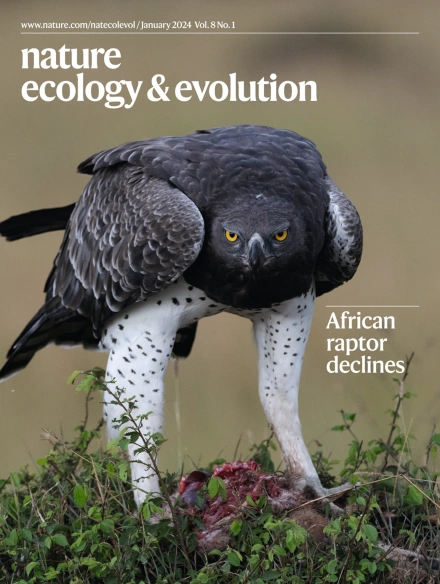15500年到15000年前的夏季温暖使得人类在欧洲西北部边缘重新繁衍
IF 13.9
1区 生物学
Q1 ECOLOGY
引用次数: 0
摘要
高强度的十年至百年尺度的气候突变对许多过去的人类种群产生了变革性的影响。然而,我们对这些人类/气候关系的理解是有限的,因为这些联系的可靠测试需要特定地区的量化古气候数据,这些数据具有足够的时间精度,以便与考古记录进行比较。在这里,我们提出了新的高分辨率古气候数据,并将这些数据与考古和动物材料的放射性碳清查相结合,以测试在末次盛冰期区域被遗弃后,人类在欧洲西北边缘(北纬50°,包括英国、爱尔兰、周围岛屿和北海盆地)迅速重新定居的能力与突然变暖之间的关系。我们讨论了这一过程的时间和格陵兰冰芯记录的气候突变的相关性。我们使用IntCal20放射性碳校准曲线显示,该地区最早的人类再繁殖发生在格陵兰岛气候变暖之前的500年。然而,我们的分析表明,西北欧边缘的部分地区此时已经经历了实质性的夏季变暖,这可能是由北大西洋东部海冰面积的变化所驱动的。相关的变暖影响了驯鹿等主要狩猎采集猎物的分布,驯鹿是人类的重要资源。因此,本研究强调了北大西洋地区在最后一次消冰期间季节性变暖的不同步性,并表明这种不同步性允许人类在距今约15200年前开发西北欧边缘的副冰川景观。本文章由计算机程序翻译,如有差异,请以英文原文为准。


Summer warmth between 15,500 and 15,000 years ago enabled human repopulation of the northwest European margin
High-magnitude decadal to centennial-scale abrupt changes in climate had a transformative effect on many past human populations. However, our understanding of these human/climate relationships is limited because robust tests of these linkages require region-specific quantified palaeoclimatic data with sufficient chronological precision to permit comparisons to the archaeological record. Here we present new high-resolution palaeoclimatic data and combine these with radiocarbon inventories of archaeological and faunal material, to test the relationship between abrupt warming and the ability of humans to rapidly repopulate the northwest margins of Europe (>50° N and encompassing the area of Britain, Ireland, the surrounding islands and the North Sea basin) after regional abandonment during the Last Glacial Maximum. We address the timing of this process and the relevance of the abrupt climate changes recorded in the Greenland ice cores. We use the IntCal20 radiocarbon calibration curve to show that the earliest human repopulation in this region occurred up to 500 years before the climate of Greenland warmed. However, our analyses show that parts of the northwest European margin had already experienced substantial summer warming by this time, probably driven by changes of sea-ice area in the eastern North Atlantic. The associated warming influenced the distribution of key hunter-gatherer prey species such as reindeer, which were a key resource for humans. Accordingly, this study highlights asynchrony in seasonal warming across the North Atlantic region during the last deglaciation and shows that this asynchrony permitted human exploitation of northwest European margin paraglacial landscapes by ~15,200 years before the present. The authors use the latest radiocarbon calibration curve and new local palaeoclimatic and palaeoenvironmental records from Britain to show that humans repopulated the northwest European margin between 15,500 and 15,000 years ago, supported by local summer warmth occurring earlier than previously thought.
求助全文
通过发布文献求助,成功后即可免费获取论文全文。
去求助
来源期刊

Nature ecology & evolution
Agricultural and Biological Sciences-Ecology, Evolution, Behavior and Systematics
CiteScore
22.20
自引率
2.40%
发文量
282
期刊介绍:
Nature Ecology & Evolution is interested in the full spectrum of ecological and evolutionary biology, encompassing approaches at the molecular, organismal, population, community and ecosystem levels, as well as relevant parts of the social sciences. Nature Ecology & Evolution provides a place where all researchers and policymakers interested in all aspects of life's diversity can come together to learn about the most accomplished and significant advances in the field and to discuss topical issues. An online-only monthly journal, our broad scope ensures that the research published reaches the widest possible audience of scientists.
 求助内容:
求助内容: 应助结果提醒方式:
应助结果提醒方式:


